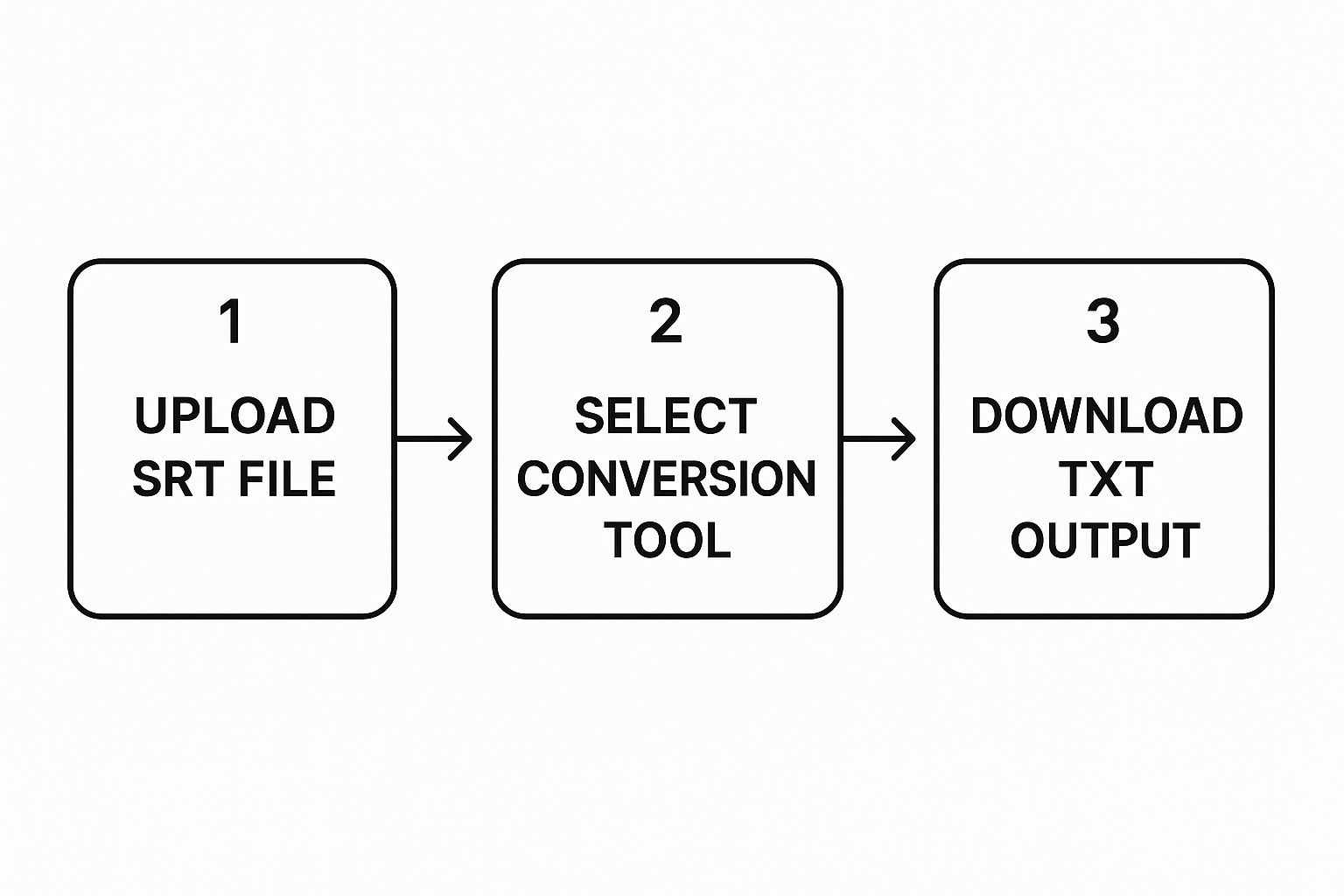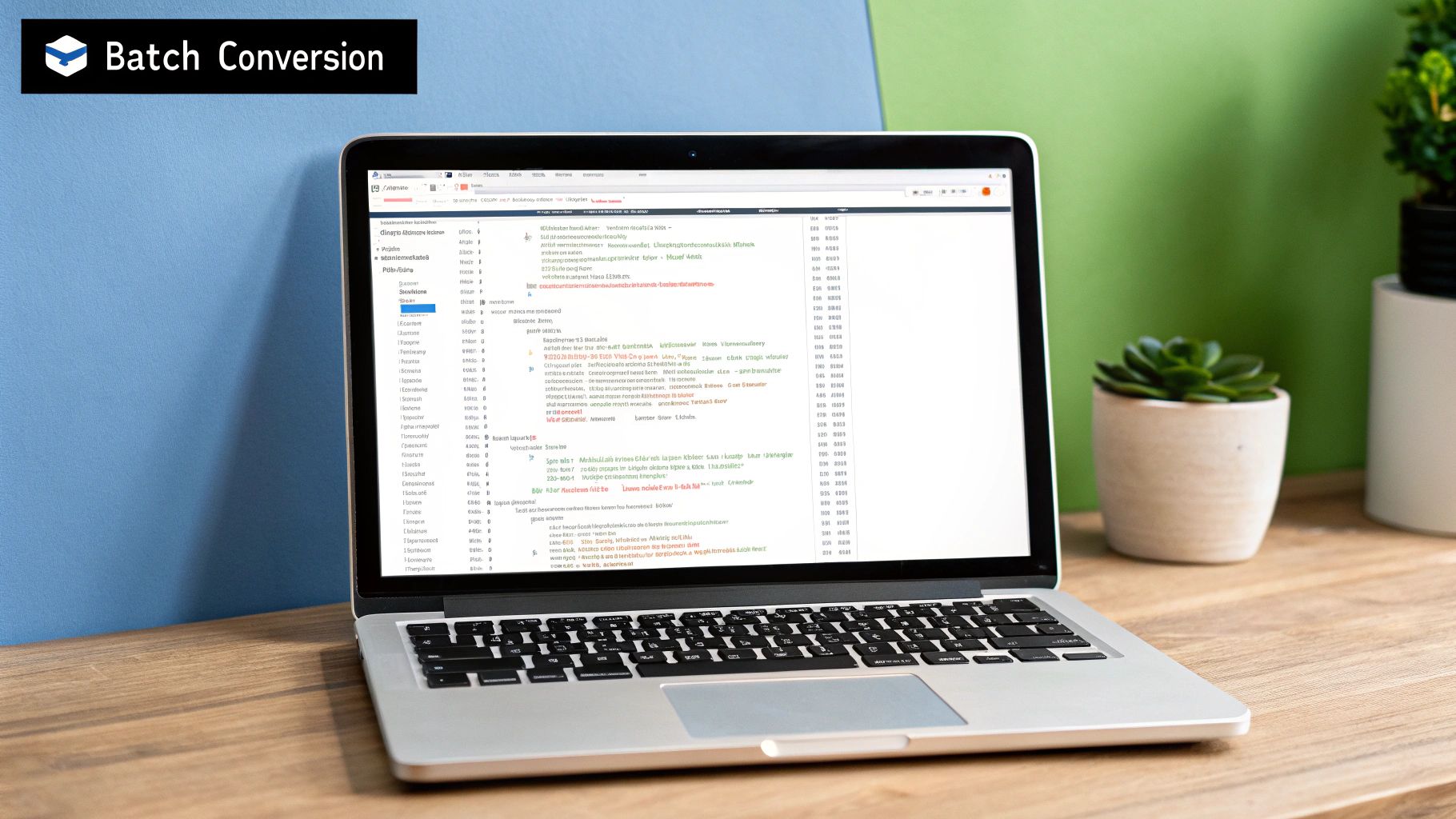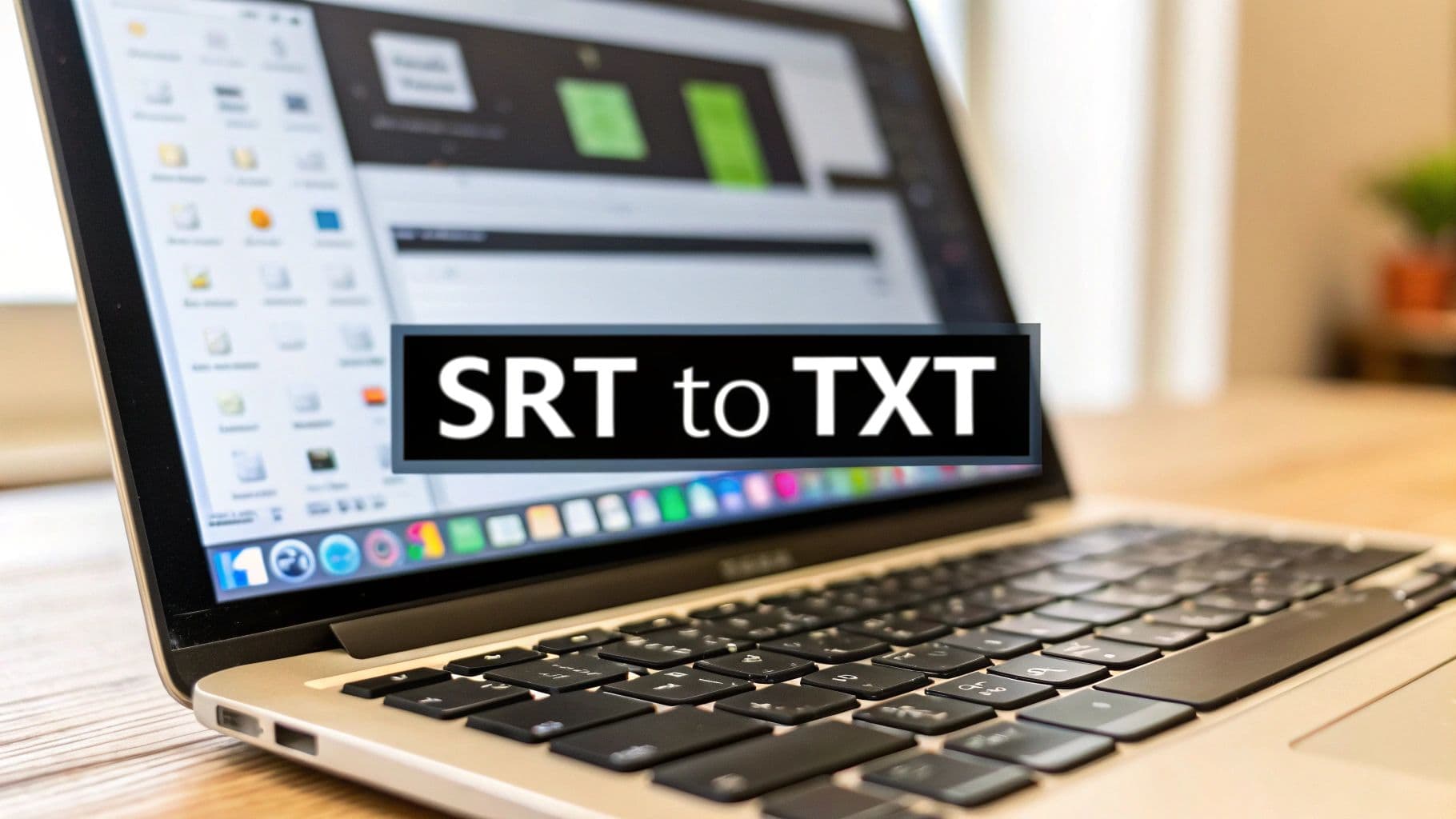Finished a video project and realized all that great dialogue is now trapped inside a subtitle file? We’ve all been there.
An SRT (SubRip Subtitle) file is fantastic for syncing text with video, but its rigid structure of timecodes and sequence numbers makes it a real pain to use for anything else. This is where converting from SRT to TXT becomes a game-changer.
Think of it less as a technical chore and more as a strategic move. A successful SRT to TXT conversion strips away all the clutter, giving you the raw text—clean, simple, and ready for action.
Multiply Your Content, Not Your Workload
One of the biggest wins from an SRT to TXT conversion is unlocking powerful content repurposing strategies. You can take the spoken word from a single video and spin it into multiple new assets.
Just imagine turning one 20-minute YouTube video into:
- A detailed blog post or how-to article
- A week's worth of social media updates or a Twitter thread
- A deep-dive email newsletter for your subscribers
- A downloadable PDF guide or handy checklist
Suddenly, you’re not just making a video; you’re creating an entire content ecosystem. Each new piece boosts your reach and SEO without you having to start from scratch. This efficient workflow is a direct benefit of the SRT to TXT process.
Get to the Point, Faster
If you're a researcher, translator, or student, you know that clean text is non-negotiable. Trying to analyze dialogue or translate a script while wrestling with timecodes is slow, frustrating, and just plain inefficient. A plain TXT file gives you a clean slate to work from.
A clean text file lets you focus on the substance of the content—the words themselves—instead of getting bogged down by the technical baggage of a subtitle file.
This need for clean, usable text isn't just a niche problem. The global market for subtitling and transcription hit USD 10.2 billion in 2024 and is projected to nearly double by 2033. That explosive growth shows just how much demand there is for turning spoken audio into useful text formats. You can dig into the numbers in this subtitling and transcription service report.
By choosing to convert SRT to TXT, you’re adopting a workflow that professionals in media, education, and corporate settings rely on to work smarter, not harder.
When to Convert SRT to TXT Common Use Cases
Not sure if a TXT file is the right move? This quick table breaks down the most common scenarios where a plain text file is a clear winner over a formatted SRT.
| Use Case | Why TXT is Better | Who Benefits |
|---|---|---|
| Content Creation | Easily copy-paste text for blogs, articles, and social media posts. | Marketers, Bloggers |
| Data Analysis | Clean text is required for NLP, sentiment analysis, and keyword research. | Researchers, Data Scientists |
| Translation | Translators can work directly with the dialogue without timecode interference. | Translators, Localization Teams |
| Archiving & Search | Plain text files are universally searchable and easy to store. | Librarians, Archivists |
| Accessibility | Provides a simple, readable transcript for users who prefer text over video. | Educators, Accessibility Advocates |
At the end of the day, converting SRT to TXT is about making your content more flexible and valuable. It’s a simple step that opens up a world of possibilities.
Introducing MeowTXT, Your Go-To SRT to TXT Converter

When you need to turn an SRT file into a clean TXT transcript, you want it done yesterday. You definitely don’t want to wrestle with clunky software or a confusing interface. That’s exactly where MeowTXT comes in. It’s built for one thing: getting the job done fast, no technical manual required.
Forget navigating a maze of menus. MeowTXT offers a dead-simple SRT to TXT process you’ll master in seconds. It’s all about speed and simplicity, making it the perfect sidekick for content creators, researchers, and anyone else who just needs to convert a file and move on. The whole experience is designed to get you from a messy SRT to a clean, usable text file as quickly as possible.
What Makes It Different?
So, what sets MeowTXT apart in a sea of online converters? It's the laser focus on the user. So many online tools are over-engineered and bloated with features you’ll never touch. This one is different. It strips away all the unnecessary junk to deliver a pure, efficient SRT to TXT conversion.
You don’t need to be a tech wizard. The platform is so straightforward that it practically holds your hand, building your confidence from the moment you land on the page. This streamlined approach is becoming the standard for modern software, and it's what makes the SRT to TXT process accessible to everyone.
The philosophy here is brilliantly simple: Upload your file, grab your text, and get back to your real work. No distractions, no hoops to jump through.
At the end of the day, MeowTXT isn’t just a converter—it’s a productivity booster. While it absolutely nails this specific task, it’s always smart to explore a wide range of useful online tools to enhance your entire workflow.
Ready to give it a try? You can start your first conversion right now by visiting the MeowTXT website.
Getting Your First File Converted, Step by Step
Alright, so you see the value in turning an SRT file into a clean TXT. Let's walk through just how ridiculously easy it is. You can forget about installing clunky software—with MeowTXT, you can have a clean text file ready to go in less than a minute. I'll take you through the entire SRT to TXT process, from start to finish.
First things first, head over to the MeowTXT website. The first thing you'll probably notice is the clean, no-nonsense interface. The upload box is front and center, designed to get you started without any friction. There are no confusing menus or a dozen settings to wade through.
How to Upload and Process Your File
You have two simple options. You can either drag your SRT file from your computer and drop it right into the designated box, or you can click inside the box to open your file browser and select it that way.
The second your file hits the server, MeowTXT kicks into gear. It works almost instantly, stripping out all the timestamps, sequence numbers, and other technical formatting that clutters up a standard SRT. This is where the magic happens—all that technical baggage is gone, leaving you with just the pure, usable dialogue from your video.
This simple, three-stage process is really the core of any SRT to TXT conversion.

It really shows how efficient a dedicated online tool can be. You get a direct path from a messy subtitle file to clean, ready-to-use text without any unnecessary steps.
Downloading Your Clean TXT File
Once the processing is done—which usually takes just a second—your clean text is ready. The tool presents the final output right there on the screen, completely free of any SRT code. It’s a good idea to give it a quick scan just to make sure everything looks right.
From there, getting your file is just a single click. You'll get a standard .txt file that's universally compatible with pretty much any text editor or word processor you can think of, on any device.
Pro Tip: Before you convert, it's a good habit to check that your original SRT file is saved with UTF-8 encoding. This one small step helps prevent any weird characters or symbols (like � or ◇) from showing up in your final TXT file. It's the key to a perfectly clean SRT to TXT conversion every time.
You've now successfully turned a restrictive subtitle file into a versatile text document. It's ready for whatever you have planned, whether that's creating a blog post, feeding it into an AI, or just having a searchable record of your video's content.
Advanced Tips for SRT to TXT Power Users

Alright, you've got the hang of converting a single SRT to TXT. Now it's time to unlock the features that really put your workflow into overdrive. If you're handling more than a few files, these next few tips will save you a ton of time.
Imagine you're a podcaster with a backlog of 50 episodes. Or a researcher with dozens of interview recordings. Converting each SRT file one by one? That’s a soul-crushing chore. This is where batch processing in MeowTXT becomes your new best friend for SRT to TXT conversions.
Instead of dragging and dropping files one at a time, just grab a whole stack of SRTs and upload them at once. MeowTXT chews through them all in a single go, turning hours of tedious clicking into a few minutes of waiting.
This isn’t just about convenience; it’s a professional necessity. The film subtitling market was pegged at a massive USD 8.5 billion globally in 2024, and Europe accounts for over 30% of that. Pros in that space aren't doing things one by one—they rely on streamlined tools to manage huge, multilingual projects.
Fine-Tuning Your Text Output
Going beyond bulk conversion, the real magic is in the automatic cleanup. Raw SRT files are often messy, littered with artifacts you definitely don’t want in a clean transcript.
MeowTXT has built-in formatting options to zap the junk for you. You can automatically remove:
- Speaker Names: Instantly nuke labels like "John Doe:" or "Interviewer:" from your lines.
- Non-Speech Notations: Get rid of distractions like
(laughs),[music fades], or(applause). - Sequence Markers: Some files have extra numbers or codes floating around. Gone.
This automated scrub gives you a pristine TXT file, ready to drop into a blog post, report, or even training data for an AI model. No manual find-and-replace required.
The whole point is to get from raw data to a finished product with the fewest steps possible. A clean transcript just looks more professional and is way easier to work with.
For those who want to push things even further, plugging your clean text into a bigger content pipeline is the next move. Check out some of the top AI content creation tools to see how you can seriously amplify what that text can do.
Finally, don't forget your export options. MeowTXT lets you create custom file names and organize exports into specific folders. It’s that level of control over your workflow that separates a basic utility from an SRT to TXT tool you can’t live without.
When Your SRT to TXT Conversion Hits a Snag
Even the slickest SRT to TXT process can hit a bump now and then. Real-world subtitle files aren't always perfect, but thankfully, most issues have a surprisingly simple fix.
A classic problem you might run into is character encoding. Ever seen your final TXT file littered with odd symbols like � or ◇ instead of proper letters? That’s almost always an encoding mismatch, a common headache with subtitles in languages other than English. The quickest fix is to open your SRT file in a text editor like Notepad++ and re-save it with UTF-8 encoding. It’s a tiny pre-conversion step that solves this issue 99% of the time.
Handling Large or Flawed Files
What about when you’re wrestling with a monster SRT file from a two-hour movie or a full-day conference recording? While MeowTXT is built to be fast, enormous files can occasionally make your browser lag during the upload. If that happens, make sure you've got a solid internet connection and try closing other browser tabs to free up some memory.
You might also come across a poorly formatted SRT file—one with missing timestamps or jumbled line numbers.
The good news? A robust SRT to TXT tool is designed to be forgiving. It'll usually just ignore the broken timestamps and focus on pulling out the dialogue, giving you a clean transcript without you having to manually repair the source file.
For more deep-dives into navigating tricky content situations, you can always find more expert tips over on the MeowTXT blog.
FAQ About Converting SRT Files to TXT

Even with a tool as simple as MeowTXT, a few questions always pop up. It's smart to be thorough. Here are the answers to the questions I hear most often from people working with subtitle files.
Can I Convert a TXT File Back to SRT After Editing?
Absolutely. Converting from SRT to TXT is a one-way street in MeowTXT, but it's a completely non-destructive process for your original file.
You can take the clean text, polish it up in any editor you like, and then use another tool (or even do it manually if you're brave) to re-sync it with timecodes and save it as an SRT again. The main job of MeowTXT is to handle that initial, messy extraction for you, giving you a clean slate to work with.
Does Converting SRT to TXT Remove Timestamps Permanently?
Not from your original file, no. The conversion simply creates a brand-new TXT file that contains only the dialogue. All the sequence numbers, timestamps, and formatting codes are left behind.
Your original SRT file stays completely untouched. Think of the TXT file as a clean copy you can use for other things, not a replacement. You can always go back to your source SRT whenever you need that timing data.
This gives you the best of both worlds: clean text for repurposing and your original, perfectly timed subtitle file safe and sound.
Are There Any Privacy Concerns with Online SRT to TXT Converters?
This is a great question and one you should always ask. Any time you upload a file, you're placing trust in that service. Reputable tools like MeowTXT get this and take data security seriously.
Your files are processed on secure servers and are never stored long-term. In fact, MeowTXT automatically deletes user files after a short window to protect your privacy. If you want to dig into the specifics, it’s always a good idea to check the privacy policy of any tool you use. You can read up on MeowTXT's commitment to user privacy on their site.



